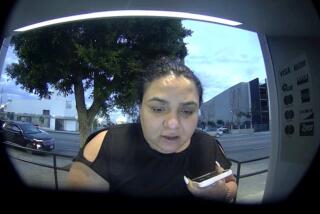Column: The Elizabeth Holmes story is not about the black and the blinks

In one way, Elizabeth Holmes has achieved her childhood dream.
In a letter she purports to have written to her father as a child, the former Theranos CEO and current potential jailbird, said she wanted to invent something new, something that no one had previously believed possible.
And she has done exactly that.
Holmes did not invent a way to diagnose a hundred diseases from a drop of blood via a high-tech machine, as she promised countless investors and the public. But she has generated a hundred new ways that professional disgrace can be parsed in the multiplatform digital universe and, in doing so, proved that many people would rather obsess over a person’s hair than contemplate the fact that we are a nation easily conned.
Which is something we really don’t want to believe.
The revelations of the Theranos fraud began with good old-fashioned investigative journalism. While Fortune and Forbes were putting swooning stories about Holmes on their covers, Wall Street Journal reporter John Carreyrou decided that it just didn’t make sense that someone who dropped out of college after two semesters could magically transform the medical industry.
His 2015 Wall Street Journal series led to Theranos’ downfall and, by the time his book came out last year, Holmes’ story was fueling every media trend going: two documentaries (à la the Fyre Festival); a podcast; a possible feature film starring an Oscar winner (Jennifer Lawrence!) and approximately 375 million stories, blog posts, memes, satiric videos and late-night jokes.
No con artist in history has been as thoroughly, swiftly and obsessively documented. Bernie Madoff ruined more lives and wreaked more economic havoc, but do you know what sort of juice he drank? Did he have a dog?
Holmes has been publicly eviscerated for bilking millions, which is a perfectly reasonable response, especially since her “new technology” involved other people’s blood and health.
But a disturbing amount of attention has been paid to her personal foibles — the unblinking gaze, the black turtlenecks, the deep voice, green juice, the dog she claimed was part wolf, the idolatrous following of the Steve Jobs template.
Many of these details also appeared in the high-volume, high-impact chronicle of her rise. Then they were seen as symbolic of her drive and unique talent. Once the fraud was revealed, however, every tic miraculously became a tell, her drive became tyranny and her talent a near-supernatural ability to bewitch men like George Schultz.
For the record, many people have weird food fads; in New York, women have been dressing in all black for years; Jobs has spawned a lot of idolatry; and it is not surprising that a young woman entering the tech world might try to speak in a lower octave.
This is not a defense of Elizabeth Holmes. From all accounts, she is a full-blown con artist capable of lying, cheating and stealing for no reason other than personal gain. There are, alas, many con artists, of varying levels of mendacity, among us. What makes Holmes different, perhaps, is that she is a woman who deceived a lot of very powerful men.
Men who could not, and still don’t quite, believe they were being lied to.
Despite the demonstrably questionable science of Holmes’ project — and her pre-packaged, words-to-say-in-meetings patter — Schultz, Henry Kissinger, Larry Ellison, Tim Draper, Gen. James Mattis and Rupert Murdoch were all early supporters and investors.
Schultz was so taken in that when his own grandson, who worked for Theranos, came to him to express concerns over fraud, he chose to believe Holmes.
As many have said in the two documentaries and countless interviews, Holmes seemed so sure of herself and why would she lie?
Even now, some of those who were duped do not think they were lied to, at least not exactly. In Alec Gibney’s HBO documentary “The Inventor,” many of those interviewed still feel that Holmes believed that what she was doing would work, eventually. Gibney told Times reporter Amy Kaufman that Holmes was not like Madoff, who knew he was using other people’s money to maintain a house of cards. Instead, she believed she was on a “noble mission,” which in her mind made it OK to “fudge the truth.”
Except she had been told repeatedly by very smart people that it would never work, and she herself could see that it wasn’t working. So unless Holmes believed in magic, she is absolutely no different than Madoff.
The “she believed it at the time” defense is exactly the kind of rationalization that con artists count on — that and the fact people do not want to admit they can be snookered. Much of history to the contrary, we still don’t believe that people will tell blatant untruths. Or if they do, we will somehow know it. In our gut.
We know all about Madoff, we watched “The Big Short,” we know Michael Cohen lied all the time on the president’s behalf because he said so, and that a bunch of rich people cheated to get their kids into a certain school and then bragged about the acceptance letters.
But we don’t believe that people will lie to us. Not some full-scale fabrication, not to our face.
And so the cons continue.
On some level, we idolize the con, only we call it charm (ignoring the fact that a charm is designed to make people do something they may not want to do). Despite having a world of information at our fingertips, we are still drawn to people who can convince us of things simply by being convincing. There will be a wall that Mexico will pay for, and it will be beautiful. There will be a Fyre Festival, on a private island, with many beautiful models in attendance.
“If it had worked out, it would have been revolutionary,” is the still-delusional mantra of many who promoted or were involved in Theranos, as if somehow there had been a chance of it working out.
Though not delusional, much of the public response is misplaced. We mock her voice and her wide-eyed stare and attempt to make her some sort of outlandish figure who everyone should have known was lying when, in fact, she is just one in a long string of liars who have taken us in, in public and private.
Maybe instead of obsessing about how Holmes looked or whether she thought her dog was a wolf, we should be asking why, after all the scandals and messy falls, we still need to create larger-than-life characters who look good on magazine covers when there are so many normal-size people doing actual good work.
Instead of acting as if Holmes were some freak of nature, we should be looking at the system that produced her. A system in which money, power and prestige are given to people just because they give good meeting or have the right connections. A system that anoints people as game-changers before they’ve changed anything but their social status.
Elizabeth Holmes may be a con artist, but we are still a nation of marks, too quick to equate money with achievement, too inclined to accept exciting image over boring fact, too willing to believe that certain kinds of people are what they say they are just because they say so.
The point of the Holmes story is not that she didn’t blink enough, it’s that she didn’t do what she said she had. If all we’ve learned is to not trust someone who dresses like Steve Jobs, we will continue to fall for the con, again and again and again.
More to Read
The biggest entertainment stories
Get our big stories about Hollywood, film, television, music, arts, culture and more right in your inbox as soon as they publish.
You may occasionally receive promotional content from the Los Angeles Times.











